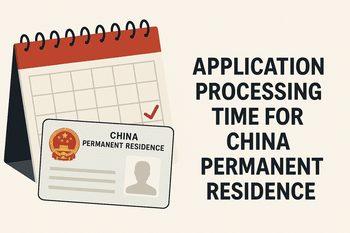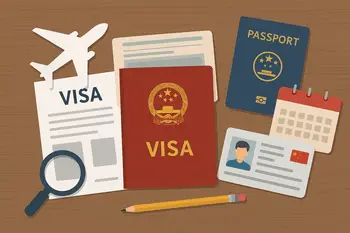
Acquiring China Permanent Residence—often referred to as the “China Green Card”—is a coveted privilege for expatriates, investors, skilled professionals, and family members of Chinese citizens.
This status not only provides the security of long-term residence but also opens the door to work, study, and access social benefits in China.
As you embark on this journey, one of the most common questions you’ll face is: “How long does the application process take?”
In this guide, we explore the intricacies of the process, factors that affect timing, and practical tips to expedite your application.
What is China Permanent Residence?
China Permanent Residence grants foreign nationals the right to live, work, and access social services in China indefinitely.
Unlike typical visas that require regular renewals, this “Green Card” offers lasting stability and convenience.
Whether you qualify as a highly skilled professional, investor, or due to family ties with Chinese citizens, the application process is governed by clearly defined eligibility criteria and meticulous administrative procedures.
For more detailed background information, you can visit:
Factors Impacting Processing Time
Several factors determine how swiftly your China Permanent Residence application is processed.
Recognizing these can help you streamline your approach and set realistic timelines:
- Applicant Category:
Different categories—investors, highly skilled professionals, or family-related applicants—have distinct eligibility criteria. For instance, professionals working in metropolitan areas like Shanghai face specific tax and salary requirements that influence processing times. - Completeness and Accuracy of Documents:
Ensuring that all documentation is complete and error-free is critical. Incomplete or inaccurate submissions may lead to follow-up requests, extending the waiting period. - Background and Security Checks:
Detailed background checks are standard. If you have lived in multiple countries, obtaining and verifying all required documents (such as police clearance certificates) may result in longer processing times. - Local Administrative Efficiency:
The efficiency of local Public Security Bureaus and immigration offices plays a significant role. Major cities like Beijing and Shanghai with digitized processes might offer faster service compared to smaller jurisdictions. - External Factors:
Policy revisions, economic conditions, or unforeseen events (like pandemics) can extend processing times.
To summarize these factors, consider the table below:
| Factor | Description |
|---|---|
| Applicant Category | Different requirements based on whether you’re an investor, high-skilled professional, or have familial ties. |
| Document Quality | Complete, well-translated, and authenticated documents speed up the process. |
| Background Checks | Encompasses criminal record, tax verification, and multi-country documentation – often a time-intensive stage. |
| Local Administrative Efficiency | Variation in response times and processing based on whether you apply in a major city or a smaller locality. |
| External Policy Factors | Changes in immigration policy or external events that can introduce uncertainty into processing timelines. |
Table 1: Key Factors Influencing Processing Time
Step-by-Step Overview of the Application Process
Understanding the process from start to finish not only clarifies expectations but also helps you prepare each step diligently.
The procedure generally follows these stages:
- Pre-Application Preparation:
Gather all necessary documents such as proof of eligibility (investment records, employment contracts, or marriage certificates), a clean criminal record from both China and your home country, and a stable source of income. Health examination reports and evidence of tax compliance are also key elements of this stage. - Submission of Application:
Submit your completed application either online or in person at the designated local Public Security Bureau. Always refer to the latest guidelines provided by the National Immigration Administration. - Initial Review and Document Verification:
Authorities review your application to verify documents. Discrepancies or missing information will require additional submissions, which can delay processing. - Background and Security Checks:
This stage involves thorough verification, including a background check and security clearances. It is common for this phase to take several months, especially if international document verification is required. - Administrative Processing and Final Decision:
A final review by senior immigration officers leads to a decision. If approved, you receive your Foreigner Permanent Residence ID Card; if denied, you may need to reapply or provide further documentation.
Consider the table below for a visual representation of the application timeline:
| Stage | Key Actions | Estimated Duration |
|---|---|---|
| Pre-Application Preparation | Document collection, translations, medical examinations, and police clearances. | 1-2 months (variable) |
| Application Submission | Online/in-person submission at the local Public Security Bureau. | 1 week to 1 month |
| Document Verification | Initial review of submitted materials with possible requests for additional information. | 1-2 months |
| Background & Security Checks | In-depth scrutiny of background information and security clearances, including multi-jurisdiction verifications. | 3-6 months (can extend in complex cases) |
| Final Administrative Processing | Comprehensive evaluation by immigration officials leading to either approval or rejection. | 1-2 months |
Table 2: Typical Application Process Timeline
This step-by-step approach will help you better gauge the time investment required and ensure you approach each stage methodically.
Comparing Processing Times Across Cities
Geographic location is another important factor affecting the overall processing time.
The table below offers a comparison of typical processing times across a few major cities:
| City | Estimated Processing Time | Notable Factors |
|---|---|---|
| Beijing | 6 to 12 months | Streamlined digital systems; stringent background checks. |
| Shanghai | 8 to 18 months | Enhanced eligibility standards include stricter tax and salary requirements. |
| Guangzhou | 7 to 14 months | Efficient local procedures but may have delays with international documentation. |
| Smaller Cities | 9 to 24+ months | Varied administrative capacities and manual processing may lengthen timelines. |
Table 3: Regional Comparison of Application Processing Times
Always check with your local Public Security Bureau or immigration office for the most current information, as regional variations can significantly influence your experience.
Reasons for Potential Delays
While many applicants follow the expected timeline, several issues can cause significant delays:
- Incomplete Documentation:
Missing or incorrect paperwork will prompt requests from authorities, resetting portions of the timeline. - Policy Changes:
Sudden changes in immigration guidelines to boost national security or manage application volumes can extend deadlines. - High Volume of Applications:
Particularly during periods of policy shifts, a surge in applications might strain administrative resources. - Extended Background Checks:
Applicants with histories involving multiple countries or complex employment records might face longer verification times.
Preparing in advance for these potential hurdles can help you manage your expectations and seek professional advice when needed.
Recent Policy Updates and Their Impact
Recent years have seen significant shifts in China’s immigration policies, especially in major metropolitan areas.
For example, updates in Shanghai have introduced stricter criteria for employment-based applicants, including detailed tax and salary benchmarks.
While these measures aim to ensure that permanent residents contribute positively to the country, they also add layers of scrutiny that can extend processing times.
Keeping track of these updates is essential. Frequently visiting the National Immigration Administration’s website or regional Public Security Bureau pages will help you stay abreast of the newest requirements.
In addition, websites like China Briefing offer regular updates on policy changes and practical insights from seasoned experts.
Tips to Expedite Your Application
Although many factors lie outside your control, the following proactive measures might help accelerate your application:
- Streamline Your Documentation:
Ensure that every document is complete, properly translated, and certified where necessary. - Stay Informed:
Regularly monitor official websites like the National Immigration Administration for policy updates. - Professional Consultation:
Consider hiring an immigration consultant or legal advisor. Their expertise can help navigate complexities and avoid common pitfalls. - Prepare in Advance:
Obtain police clearance certificates and tax compliance documents well before the submission deadline. - Maintain a Robust Profile:
Demonstrate your commitment through solid evidence of employment, investment, or family ties, which can reduce the level of scrutiny your application faces.
These steps can make your application process more efficient and help you overcome some of the bureaucratic challenges inherent in the system.
Frequently Asked Questions
Q: How long does it typically take to receive a decision?
A: While some applicants see results within six months, many cases—especially those with more complex documentation—may take a year or more. The exact timeline depends on factors like applicant category and local administrative capacity.
Q: Can I track my application status online?
A: In many cities, advanced digital tracking systems allow for status checks. Visit your local Public Security Bureau’s website or the National Immigration Administration for more information.
Q: What should I do if my application is delayed?
A: First, ensure that your documentation is complete. Then, consider reaching out to the relevant agency or seeking professional legal advice.
Sources and Further Reading
For more detailed and up-to-date information, refer to the following trusted resources:
- National Immigration Administration (China):
http://www.mps.gov.cn/ - Expatica on Living in China:
https://www.expatica.com/china/ - China Briefing (Policy Updates and Insights):
https://www.china-briefing.com/
Additionally, you may consult relevant sections on Wikipedia for a general overview on immigration policies in China.
Conclusion
Navigating the journey toward China Permanent Residence is an exercise in diligence, patience, and strategic planning.
The process—from careful document preparation and strict eligibility checks to background verifications and final administrative reviews—can span anywhere from several months to over a year.
However, understanding the factors that influence timing, utilizing comparison tables, and following best practices can help smooth the process.
Staying informed via external resources, leveraging professional assistance, and preparing meticulously for every stage of evaluation will empower you to manage your expectations and expedite your application wherever possible.
As you move forward, keep in mind that the regulatory landscape can evolve, so maintaining regular contact with official sources and expert advisors is indispensable for success.
With careful planning and a proactive mindset, securing China Permanent Residence can be a manageable step toward a secure future in one of the world’s most dynamic countries.


